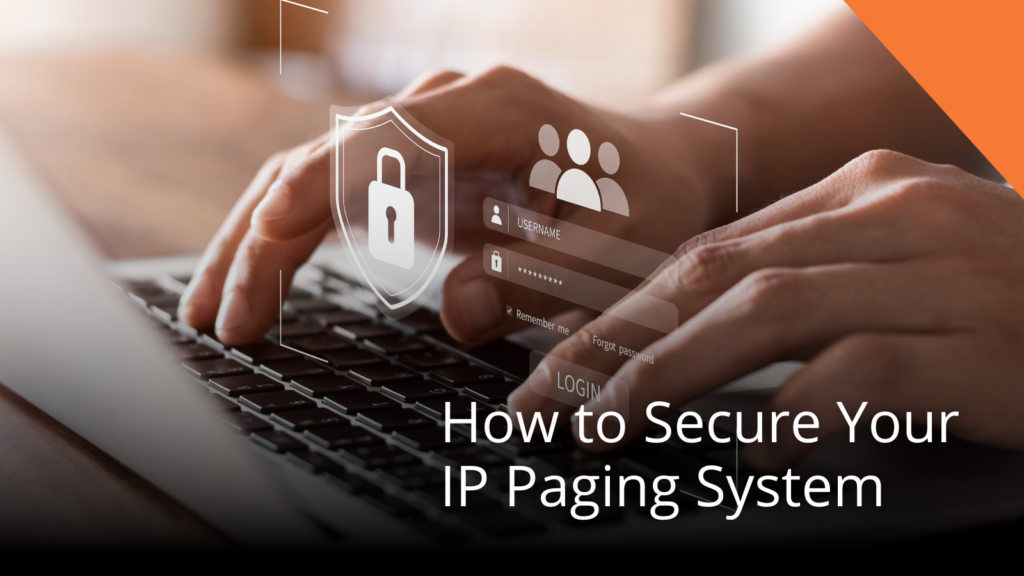How To: How to Secure Your IP Paging System

Paging Dr. Smith, Clean Up Aisle 2, Johnny Report to the Office, Lost Car Key at Customer Service, etc. These are just some of the things you may hear on a daily basis over an IP Paging System. However, IP Paging Systems have become critical solutions for safety and security purposes. These systems have gone beyond the scope of just formal announcements and created devices to help keep everyone safe, alert, and aware. The last thing you would want to happen is to have your IP Paging System hacked or breached in any way deeming it utterly useless when you may need it the most. To ensure your IP Paging System remains safe and secure, follow these best practices to minimize risks and protect your communications infrastructure.
Implement Network Segmentation
Start by segmenting your network. Place the IP Paging System on its own VLAN (Virtual Local Area Network), separate from other critical services like email and VoIP phone systems. This isolation helps contain any potential breach and limits the exposure of your core network to unauthorized access or attacks.
How?
- Create a dedicated VLAN for your IP paging devices.
- Configure access control lists (ACLs) to limit traffic between VLANs.
- Use a firewall to monitor and filter traffic to the paging system.
Use Strong Authentication
Weak or default login credentials are one of the most common vulnerabilities in IP devices. Ensure all administrative access to your IP Paging System is protected with strong, unique passwords. Whenever possible, implement multi-factor authentication (MFA) to add an extra layer of security.
How?
- Replace default usernames and passwords immediately after installation.
- Use complex passwords with a mix of characters, numbers, and symbols.
- Enable MFA for administrator logins if supported by your IP paging system.
Encrypt Communication
Ensure that your IP Paging System supports and uses secure communication protocols, such as TLS (Transport Layer Security) and SRTP (Secure Real-Time Transport Protocol), to encrypt voice and control data. This prevents unauthorized eavesdropping or manipulation of messages as they are transmitted over the network.
How?
- Check if your IP Paging System supports encryption protocols like TLS or SRTP.
- Enable encryption in the system’s configuration settings.
- Regularly update encryption certificates and protocols to maintain security.
Keep Firmware Updated
Manufacturers frequently release firmware updates to patch known vulnerabilities and improve system security. Regularly check for updates to your IP Paging System and apply them as soon as they become available.
How?
- Set up notifications for firmware updates from your system manufacturer.
- Test updates in a controlled environment before deploying them to production systems.
- Create a regular schedule for checking and applying firmware updates.
Monitor System Activity
Proactively monitoring your IP Paging System for suspicious activity can help you detect and mitigate potential threats before they escalate. Use network monitoring tools to track traffic and set up alerts for unusual patterns, such as repeated login attempts or traffic spikes.
How?
- Enable logging on your IP Paging System to capture access and event data.
- Use network monitoring tools like SNMP (Simple Network Management Protocol) or syslog to track activity.
- Set up alerts for failed login attempts or significant changes in traffic volume.
Disable Unused Features
IP Paging Systems often come with features that may not be necessary for your particular use case, such as remote access or unused protocols. Disable any unnecessary features to reduce the potential attack surface of your system.
How?
- Review all enabled features and services in the system settings.
- Disable remote access features unless absolutely necessary.
- Turn off unused protocols or ports to minimize vulnerabilities.
Regularly Review Security Policies
The security needs of your IP Paging System may evolve over time. Conduct regular reviews of your security policies, including user access permissions, encryption standards, and network configurations, to ensure they remain up to date with best practices.
How?
- Schedule routine audits of your paging system’s security settings.
- Reevaluate user permissions and remove access for inactive users.
- Stay informed about new security threats and adjust your policies accordingly.
More Resources For You
SIP Paging System Basic Tutorial
Enhancing School Security: The Impact of Upgrading IP Paging Systems
Two-Part Intercom Solutions for Added Security with IP Paging
Alyssa’s Law & Silent Panic Alert Technology
Securing your IP Paging System is critical to ensuring the safety and reliability of your communication network. By following these best practices—such as network segmentation, strong authentication, encryption, and regular updates—you can minimize vulnerabilities and protect your system from potential attacks. Stay proactive, monitor your system closely, and always be ready to adapt to new security challenges as they emerge. If you have comments or questions leave them below, chat with one of our VoIP Experts at www.voipsupply.com, or call us at 1-800-398-8647.